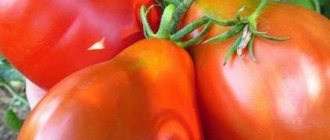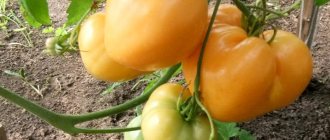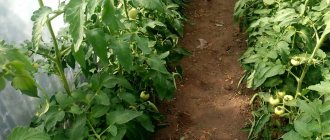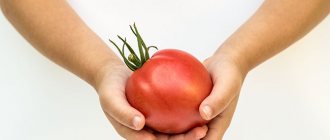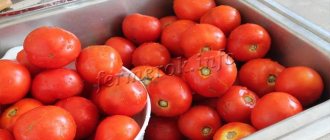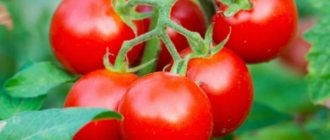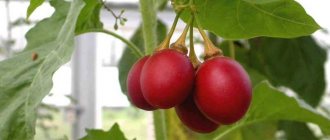Description of the Lazy Tomato
The Lentyayka tomato is a universal variety, the result of the work of Russian scientists and an example of Siberian selection. In 2010, it passed state registration. Due to the ability of tomatoes to maintain high yields in different climatic zones: in the regions of central Russia, in areas with colder climates, their growing area is wide. In the Astrakhan and Volgograd regions, Kuban and the Caucasus, tomatoes are planted in open ground, in the regions of the Urals and Siberia - in greenhouses and under film.
Plants are determinate. Their growth continues until 4–6 inflorescences form at the top. During this period, tomatoes must be tied to a support, since with the development of ovaries and fruits and the growth of lateral shoots, the branches bend down and break.
Distinctive characteristics and description of the lazy tomato variety are short stature and compactness. This is important in cases where the crop is grown in greenhouses or in small summer cottages where planting area is limited. In the photo of Lazyman tomatoes, you can see that the trunks are straight and dense, their height reaches 40 - 60 cm. The bushes grow both upwards and to the sides. In this case, the side shoots grow along the entire length of the trunk, small clusters of 2–4 tomatoes appear on them.
Tomatoes of the Lazyman variety need to be planted only until the first cluster appears on them. Then additional shoots develop on the plant, and tomato bunches are formed on them.
Growing regions
The Lentyayka tomato variety was bred by enthusiasts specifically for the conditions of Siberia, the Urals and central Russia. It thrives in open ground and in greenhouses and bears fruit abundantly.
Additional Information! In the Urals and regions of Siberia, seedlings must be covered with film, and in the arid regions of Russia they must be watered abundantly.
"Lazy" - tomato for the lazy
Agro is known for the high quality of garden seeds and a variety of offers. Among the new tomatoes is the Lazy Guy variety, which is still little known to a large circle of summer residents, but already has its fans.
But in any case, to get a harvest, you will have to work hard: grow seedlings, provide watering and fertilizing for the tomatoes. And then Lazy Girl will surprise you and delight you with beautiful, delicious fruits.
A variety from the group of determinate tomatoes, height – 50-60 cm, which allows it to be grown in small greenhouses and tunnels. Standard type bush, compact, with regular leaves. The first fruits are harvested after 85-95 days, that is, an early tomato, ideal for regions with harsh climates.
The breeders' task was to develop a variety with large fruits and early harvest dates for cultivation in open ground, which in the end was quite successful. The tomatoes of the Siberian tomato variety Lentyayka are very large and have a rich crimson color. Weight – 300-380 grams, the skin of the fruit is dense and thin. The shape is heart-shaped, so when the crop ripens on the bushes, the appearance of the plants is very elegant.
The pulp is medium dense, there are 4-6 chambers inside, there are few seeds. The taste of the fruit is sweet with a very slight sourness. Use – salads, fresh, also preparing pasta, juice, sauces. Only small tomatoes are suitable for canning and pickling; large specimens are cut into slices and rolled into assorted dishes, lecho, and pickles.
The Lazyman variety is a productive tomato; you can collect 4-5 kg of fruit from a bush. Tomatoes are tastier from plants grown in beds, but a lot depends on care and weather conditions.
Exceptional tomato qualities
Tomatoes contain carotenoids, pectin substances, chemical and biogenic elements, and organic acids. In terms of vitamin C content, they are ahead of lemons and oranges, and in terms of potassium content, they have no equal at all. Tomatoes protect the body's cells from destruction by free radicals, from the development of cancer, and bone destruction.
Attention! Tomatoes should be consumed with caution by people with high stomach acidity, the presence of gallstones and allergy sufferers.
Today, this storehouse of vitamins can be grown in the southern regions and in areas with harsh climates. One of these tomatoes, which is able to withstand significant temperature fluctuations in northern latitudes, is the Lazy Guy variety.
Tomato variety Lentyayka is suitable for growing in any climate
Appearance
In shape, and many specimens also in size, the fruits of the Lazy Guy tomato resemble the fruits of the Novosibirsk varieties Velmozha, Heavyweight of Siberia or Pudovik. However, unlike them, which are colored pink or raspberry-pink, the color of the Lazy Girl is closer to pure red, although in a certain state of ripeness it has pinkish tones. This is the kind of tomato that makes you want to cut it and eat it as quickly as possible, because it makes you confident that the flesh is sweet and tasty. Indeed, the taste of the Lazy tomato is excellent, but they say that some sourness is still present against the background of the main sweet taste.
The real Lazy Girl is painted bright red, but it is often said that she is almost pink: whether this is true or a mismatch is difficult to say.
Tomato bushes
The bushes are low-growing and compact (standard variety). Height - 60-65 cm. In this regard, gartering and the formation of bushes are not necessary, however, they are recommended and we will talk about this below. Therefore, not very experienced gardeners can safely begin their acquaintance with growing their own tomatoes with this variety.
With ideal care, we recommend pinching below the first brush and removing the top of the bush at the level of half a meter.
Up to six inflorescences are formed on the bush, the stem is straight and not subject to large growth, so it will feel great in unprotected soil and in low greenhouses. Brushes are formed on the side branches, so topping is necessary. And although the bush is not tall, due to the heavy fruits, in order to avoid breaking the stems, tying to pegs is required. In addition, if the fruits are in contact with the soil, they are more susceptible to diseases and pests can more easily reach them.
In general, the Lazy tomato is resistant to diseases, provided timely preventive measures are taken.
Description of fruits
The fruits of tomatoes of the Lazyman variety are set together. The ovaries are mainly formed on the lateral stepsons. The shape of tomatoes is heart-shaped, and the color can vary from bright red to close to crimson. The skin is smooth, dense and at the same time tender. Thanks to this, the fruits are well preserved during transportation.
A description of Lazy Guy tomatoes will be incomplete without an indication of their taste. The fruits are pleasant and sugary. Unlike many other varieties of tomatoes, Lentyayka does not have a pronounced sourness, so it is classified as a dessert variety.
If you cut a tomato, it reveals juicy, tender flesh of a rich red color with 4 to 5 partitions. The seed chambers are almost invisible. The density of the pulp is average, the proportion of dry matter is 4 – 5%.
Description, characteristics of the Lazy Guy variety with photos
The Lazy Tomato appeared thanks to the work of Siberian breeders. The variety was included in the State Register of the Russian Federation in 2017.
- In the central part of the country, in Siberia and the Urals, this variety is recommended to be grown in greenhouses and indoor greenhouses.
- In the southern regions, tomatoes can be planted in open ground.
The Lentyayka variety is an early-ripening, determinate standard-type tomato. The growing season from germination to the first harvest is 85-90 days.
- This variety forms a compact bush 55-60 cm high.
- Since the plant is standard, it does not need shaping. The central trunk is strong.
- The leaves of the plant are of medium length. Their color stands out with a beautiful emerald hue.
- Inflorescences are complex. 2-4 tomatoes are tied on one fruit cluster.
Since the variety is early ripening, the first ripe tomatoes appear at the end of June.
- The plant has good immunity to various diseases, including late blight. But various pests attack this tomato quite often.
- There are a lot of fruits on the bushes, and they are quite heavy, so the trunk and fruit clusters must be tied to a support.
- The fruits of the Lazy Lazy tomato are bright red or red-crimson, heart-shaped. The skin is thin, but dense, with a glossy sheen. The pulp of the fruit is juicy and tender, bright red in color.
- Tomatoes have a sweetish taste, with almost imperceptible sourness. Suitable for use in fresh salads, as well as for making juices and ketchups.
Fruits harvested ahead of time are capable of ripening, but their taste does not change.
Characteristics of tomatoes Lazy
The characteristic features of the variety are its early ripening and the combination of short stature and large size of tomatoes. And the fact that the crop can be cultivated in many regions without the use of artificial shelters makes it very attractive for gardeners.
Resistance to diseases and pests
The lazy tomato variety is resistant to such common diseases as macrosporiosis and late blight. This is one of the advantages of the plant. At the same time, slugs and mole crickets pose a threat to tomatoes. These pests usually appear on mature bushes.
Important! Tomatoes that grow in greenhouses and greenhouses are often subject to fungal diseases.
Productivity and fruiting
The Lazy Guy variety is early ripening. The period from planting to the ripening of the first fruits averages 95–100 days. With this growing season, the first tomato harvest can be harvested at the end of June.
The productivity of the variety is high. It is achieved due to the good immunity of plants and their resistance to diseases. I get about 4 kg of tomatoes from the bush. With the preferred planting scheme, 6 plants per square meter. m, the yield indicator is 20 kg.
Productivity
Tomatoes of the Lentyayka variety belong to the category of large-fruited varieties. Although the bush of the plant is not large in size, quite large tomatoes grow on it. This is considered rare for determinate varieties.
On average, the weight of one tomato is 250-350 grams. With proper and regular care of the plant, the weight of the fruit can increase up to 500 grams.
The Lentyayka variety is distinguished by good fruiting. In good weather conditions, you can harvest up to 5 kg of tomatoes from one bush.
In unfavorable weather, yields are reduced. If you follow the proposed planting scheme of 4-5 bushes per 1 sq. meter, then you can collect more than 20 kg of ripe tomatoes.
Optimal growing conditions
In the northern regions, the Lazy Guy variety still needs a greenhouse. And when grown in the south and in the regions of the middle zone, it feels great in open ground.
Advantages and disadvantages of the variety
The Lazy tomato variety has gained many fans over the short time of its existence. Gardeners value it for the fact that:
- the bushes are compact in size and at the same time have good productivity;
- plants are resistant to temperature fluctuations and cool climates and have strong immunity;
- tomatoes are large, juicy and tasty;
- they can be used for fresh salads and for preparations;
- The fruits ripen together, are stored for a long time, and can be transported without problems;
- plants are able to bear fruit until the onset of frost.
Like any variety, Lazy Guy also has its drawbacks:
- has difficulty withstanding dry, hot weather, during such periods it requires abundant watering, and with a lack of moisture, productivity indicators decrease;
- needs strong supports during fruit ripening;
- demonstrates active growth and good yield only on fertile soils with neutral acidity.
The number of advantages is noticeably greater than the disadvantages. However, the choice in favor of the tomato variety remains with the gardener.
Pros and cons of tomato
Early ripening Lentyayka tomatoes stand out among other varieties with the following positive qualities:
- unpretentiousness to growing conditions;
- good yield;
- storage duration;
- ideal for small gardens or summer cottages;
- suitable for growing in small greenhouses;
- rapid fruit ripening;
- good transportability;
- bushes do not need shaping;
- do not require special care;
- ripe fruits have an unusually pleasant taste, both fresh and canned;
- resistance to temperature changes;
- immunity to fungal diseases.
But besides the advantages, the Lazy tomato also has several disadvantages:
- does not tolerate high air temperatures and drought;
- needs a garter, otherwise the plant will break under the weight of the fruit;
- not suitable for whole-fruit canning;
- It develops well and bears fruit only on fertile soil.
If we take into account all the positive qualities of the variety, then its disadvantages will be quite insignificant.
Diseases and pests
Due to the fact that the Lentyayka variety is characterized by early ripening, its fruits are not susceptible to late blight.
There is a great tool:
iodine from late blight of tomatoes
The plant also has high resistance to macrosporosis.
The main pests that can attack Lazy's tomato bushes are mole crickets and slugs. And if the mole cricket causes damage to young plants, then slugs usually appear on adult bushes. Methods for controlling these pests are standard, as for other vegetable crops.
Photo of the tomato pest - mole cricket
Photo of tomato pest - slugs
When growing the Lentyayka tomato variety in greenhouse conditions, you should remember that in closed ground, fungal diseases are typical for any variety of tomatoes.
Advice!
To prevent the Lentyayka bushes from being damaged by fungal diseases, it is necessary to regularly ventilate greenhouses to avoid increased humidity in the air and soil.
Planting seedlings
Since Lazy is an early-ripening tomato variety, its seeds begin to be planted for seedlings in mid-March. The sowing time may vary in different climatic zones. In order to calculate them correctly, it must be taken into account that tomatoes are transplanted into open ground 45 - 50 days after planting the seeds.
Before sowing, tomato seeds must be calibrated and prepared. To do this, you can use the following scheme:
- Prepare a weak solution of potassium permanganate or hydrogen peroxide, which has a disinfecting effect.
- Soak the planting material in it for 15 minutes.
- Wash the seeds.
- Leave overnight in a mixture of diluted growth stimulator and complex mineral fertilizer.
When the preparatory work is completed, the seeds are planted in containers filled with moist substrate at a distance of 2 - 3 cm. The planting material must be deepened by about 1.5 cm.
Immediately after sowing, the containers are covered with film and kept at a temperature of 24 - 26 ° C. In the first days no watering is required.
When the seeds germinate, containers with seedlings are moved to a cooler place, where the air temperature is approximately 15 ° C, and temperature differences between day and night do not exceed 2 - 3 ° C. After the formation of two true leaves, the seedlings need to be pricked.
Advice! It is convenient to use peat pots for picking plants: when transplanting into the ground, young shoots are not damaged. In addition, the pots act as fertilizer.
Growing seedlings
Soil for sowing in the spring can be bought at any flower or agricultural store, but it is better to further treat it - steam, calcinate or spill with the same potassium permanganate. Next, you need to deepen the Lazy tomato seeds 1-1.5 cm into the moistened soil and cover with film until the first shoots appear. The temperature at this time should be maintained around +25 degrees, but after the seedlings appear, it should be lowered by 7-9 degrees. This is necessary in order to slow down the growth of plants a little and allow them to get stronger. At the same temperature, tomatoes will grow quickly and stretch into thin strings, which will make them brittle and weak.
The seedlings must be planted at the usual time for all tomatoes - after the appearance of the second true leaf. At this moment, it is worth carrying out a second sorting - discarding all weak plants that are noticeably inferior in growth to the rest. And also when replanting, you need to carefully examine the roots to identify signs of root rot, if any. A couple of weeks before transplanting tomatoes to a permanent location, begin hardening off the plants. First, take them out into the air during the day, leaving them in the shade and gradually increasing the time spent outside, then start leaving them at night (if the air temperature does not drop below +10...+12 degrees).
Tomato transplant
Seedlings that are planned to be planted in open ground can be hardened off 50 days after sowing. To do this, containers are placed on the balcony. Tomatoes that will grow in a greenhouse can be transplanted to a permanent place 45 days after sowing.
It is recommended to prepare the soil for plants in advance. When digging, you need to add ash, humus, as well as mineral fertilizers: potassium and ammonium nitrate, superphosphate.
Planting holes for transplanting bushes of the Lentyayka variety can be placed at a distance of 20 cm from each other. On an area of 1 sq. m fits 6 plants. Young shoots are placed in the holes, the roots are sprinkled, and watering is carried out.
Lazy Tomato: reviews from those who planted and grew the variety
Olga, 45 years old, Kovrov: I chose the Lazy tomato variety from photographs on the Internet. I really liked the description of the Lazy Guy tomatoes - unpretentiousness, compactness, high yield with little care, early ripening of fruits. I grew the variety by seedling method, it should be noted that seed germination is almost 100%. The seedlings were transplanted into a greenhouse in mid-May. I planted the plants at a distance of 0.5 m. The bushes grew compact and low, but the yield was really good - I think I collected 5 kilograms per bush, and there was active ripening around the end of July. I will plant this variety in the future.
Natalya, 35 years old, Strunino: By chance, along with other varieties of tomatoes, I bought Lazy Girl. But I never regretted it later. The tomatoes look exactly like the photo on the seed packets. They are delicious, I used the fruits not only for food, but also for twists. My family especially liked the pickled tomatoes - they did not lose their taste and did not crack during heat treatment. And the yield of the variety is really high - enough for both food and canning. I will continue to plant.
Larisa, 55 years old, Serpuzov: I have been planting seeds of this variety for several seasons. I would like to say that bushes of this variety require mandatory garter. Moreover, I tie up the stems and put strong subcortex under the ripening clusters, otherwise they may not be able to withstand the weight of the ripening fruits and break off. To get a good harvest, you still have to work hard - water it on time, apply fertilizer.
The Lentyayka tomato variety is intended for cultivation in most Russian regions; it is highly resistant to cold,
but still, in the Urals and Siberia, it is recommended to grow Lazywort in a greenhouse to protect the plants from too much cold during the season.
Subsequent care for tomatoes
Plants need sufficient moisture. Based on reviews and photos of Lazy Lazy tomatoes, we can conclude that in moderately warm weather they need to be watered once a week, in hot and dry weather - twice a week.
To achieve good yields, plantings must be weeded from time to time, not forgetting to loosen the soil. Tomatoes need feeding. Fertilizers should be applied during the growing season, alternating organic and mineral fertilizers. It is enough to do this 3–4 times per season.
Important! An indispensable condition for a good harvest of Lentyayka tomatoes is pruning all the stepsons located below the first bunch.
Sufficient watering
After the formation of 2 true leaves, the seedlings are picked and transplanted into a spacious container. For these purposes, it is better to use peat pots, then the sprout can be placed in open ground along with the pot.
Plants are planted in the ground at the end of May or beginning of June, depending on the growing area and weather conditions. Before being placed in open ground, pots with seedlings are taken outside during the day, first for several hours, gradually increasing the time, then overnight, provided that the temperature is not lower than +10 °C. This way the seedlings are hardened.
The Lazy Guy variety is not picky about soil, but it is preferable to plant it on neutral soil with good air exchange. In dry areas, additional watering is required. Plants are well adapted to frost, but not at all adapted to heat.
It is better to water with fertilizers dissolved in water, since this variety of tomatoes does not absorb nutrients found in the soil. Preferably with warm water and under the root. Excessive humidity can cause fungal diseases.
Fertilizers
During the period of growth and development, plants receive three feedings, alternating organic matter with mineral fertilizers. When fertilizing tomatoes, iodine, hydrogen peroxide, boric acid, yeast, and ammonia are used.
Stepson and garter
Stepchildren that grow below the first brush are recommended to be cut off. It is better to tie up the bushes, otherwise the branches will lie on the ground under the weight of the tomatoes, which will affect the harvest. To quickly ripen the crop, you can use covers and growth stimulants.
Planting in the ground begins at a stable temperature of +10-20 ° C
Recommendations for cultivation
In our latitudes, the tomato variety Lentyayka, like other varieties, is grown through seedlings. Its preparation begins in March, 50–55 days before planting in a permanent place.
Advice! Those gardeners who want to start harvesting this early variety even faster can plant seedlings in a permanent place at the age of 45 days from emergence.
At the same time, seeds for seedlings should be planted no earlier than mid-March.
Despite the fact that almost all seeds undergo pre-sale preparation, experienced gardeners recommend sorting and processing them yourself. To do this you need:
- Immerse all seeds in water. Those seeds that float to the surface are empty and will not be able to germinate. Therefore, they are not allowed to board. In addition, you should not plant small and damaged seeds - most likely they will not sprout.
- Selected seeds must be treated with a weak solution of potassium permanganate for 15 minutes. After this, they must be rinsed with warm water.
- Soak the seeds in water with the addition of mineral fertilizer or growth stimulant. The soaking period should not exceed 12 hours.
By sorting and processing seeds, you can achieve not only 100% germination, but also significantly strengthen the immunity of young plants.
When planting seeds for seedlings, you should adhere to a sowing depth of 1.5 cm. Deeper or shallow planting will not allow the seeds to germinate normally. In order for seedlings to appear as quickly as possible, it is necessary to provide them with a temperature of 20 to 26 degrees. After the majority of seedlings have appeared, it is recommended to lower the temperature. During the day it should be 14 - 16 degrees, and at night it should be between 12 - 14 degrees.
To make it easier for the plants of the Lazyman tomato variety to be transplanted to a permanent location, they must be hardened off. The hardening procedure is quite simple - young plants are taken out to the balcony at night or placed near an ajar window. At the same time, in order to avoid stretching the seedlings, the containers should be covered with film at first.
Important! Hardening is carried out at a night temperature of at least 10 degrees.
Picking of Lazy Girl seedlings is done after the formation of the first two leaves. At the same time, they must be replanted carefully, without damaging the weak root system of the plants. During picking, each plant must be inspected and if root rot is detected, discard it. In addition, you should not give weak seedlings a chance. Especially if it is planned to be planted in open beds.
The lazy tomato variety, despite its low maintenance requirements, may not grow on all soils. Its seedlings should not be planted on heavily fertilized acidic soils. Beds with loose soil of medium or neutral acidity will be optimal. If crop rotation is organized on the site, then beds are perfect for Lazy Girl after:
- carrots;
- Luke;
- cucumbers;
- cabbage;
- legumes
Important! Tomatoes should not be planted after potatoes or peppers for 3 years. These crops will not leave any beneficial substances for tomatoes.
Preparing tomato seedlings Lentyayka
In terms of agricultural technology, the Lazy tomato is not much different from the others. It all starts with seedlings. At the time of transplantation to a permanent location, plants must be at least 50 days old. In southern regions, 45 days are allowed. So determine the timing of sowing seeds based on this information. In any case, there is no need to plant Lazy Tomato seeds until mid-March. Because the seedlings will outgrow. It will also be difficult to take root in a new place.
Before going on sale, all Lazy tomato seeds undergo pre-treatment. But experienced gardeners still advise doing the sorting and preparation yourself. First, place the Lazy Tomato seeds in water. Some of them will sink to the bottom. And others will float to the surface. All floating seeds can be discarded. Because they are empty. Planting them will only waste your time. Nothing can grow from them.
And also discard all the small seeds of the Lazy Tomato. Even if they germinate, the plants will most likely be weak. But those Lazy Tomato seeds that sank to the bottom are heavy. This means they are suitable for planting. After selection, soak the planting material in potassium permanganate for 15-20 minutes. Then rinse and soak again. This time in a growth stimulator solution for 10-12 hours. Thanks to this treatment, you will not only get one hundred percent germination. But you will also significantly increase the immunity of future tomato bushes.
Harvesting Lazy Tomatoes
Lazy Tomatoes are an early ripening variety. Harvesting begins within three months after the appearance of the first shoots. The fruits have a smooth, dense, strong skin that tolerates transportation well without losing its presentation.
You can make any preparations for the winter from tomatoes: salt, freeze, boil juice, tomato paste. The only thing is that tomatoes cannot be preserved whole in jars due to their large size.
Harvesting Siberian tomatoes
By purchasing seeds of the Lentyayka variety, you can provide yourself and your family with a tasty and healthy vegetable with high yield and ease of care for the whole year. Growing it does not require special deep knowledge of a professional; a novice summer resident can cope with this.
Farmers like the variety for its productivity, ease of care, early ripening, beautiful presentation, which is not lost during transportation.
Lazy tomatoes: reviews, crop photos, description of an unpretentious variety
Until recently, there were too few varieties of tomatoes that could be grown in the difficult climatic conditions of central Russia, in Siberia and the Urals.
But the situation changed when the country's breeders decided to breed tomatoes that would tolerate temperature fluctuations and stressful situations, were unpretentious, did not require special care, and at the same time had excellent productivity.
One of these tomato varieties bred by breeders in the last decade is the Lazy Tomato.
. The name of the variety already suggests that it is intended for those vegetable growers who have just started growing vegetables in their garden, or who are tired of intensive care for vegetables in their beds.
Characteristics of Lazy Guy tomatoes, advantages, reviews and nuances of cultivation will be described below.
The content of the article:
History of the creation of the variety Main characteristics and features of the tomato variety Lazyr Yield of the tomato variety Diseases and pests Advantages and disadvantages of tomatoes Lazyr: planting seedlings, growing, caring for tomatoes in the garden Further care Feeding tomato bushes Reviews of those who planted and grew the tomato variety Lazyr
Pest and disease control
Tomatoes growing in open beds, subject to moderate watering, are resistant to diseases, including fungal ones. When growing in greenhouses, to prevent them from planting, it is necessary to ventilate.
If pests, such as slugs, aphids or mole crickets, appear on tomatoes, they should be treated with special preparations. To eliminate aphids, you can use a soap solution. And to combat thrips and mole crickets, prepare a solution:
- Add a tablespoon of chili pepper and 2 tablespoons of mustard powder to a bucket of water.
- The soil is loosened and sprayed with a solution.
Pests
Plants are defenseless against pests such as:
- aphids - they are washed off with a generous solution of laundry soap;
- thrips - I treat them with the preparation “Bison”;
- mole cricket - it is bred with a mixture of hot pepper and mustard powder (1 tablespoon of the mixture per 10 liters of water);
- slugs - they are collected, the soil is thoroughly loosened, preventing the soil from becoming waterlogged.
Important! Tomatoes planted in places where potatoes, tomatoes or peppers previously grew are most often susceptible to pest damage.
Plantation of tied tomatoes
Advantages and disadvantages
The value of Lazy Guy can be determined by considering the advantages of the variety:
- Tomatoes produce a large harvest of large fruits.
- Tomatoes have a very high tasting rating from experts.
- Dense pulp and strong skin have a positive effect on storage and transportation.
- The species is resistant to sudden changes in temperature and does not lose productivity in cool climates.
- Standard-type plants are characterized by low growth, which eliminates the need for formation.
- When growing Lazy Lazy tomatoes, you can do without pinching.
- The early onset of fruiting allows tomatoes to ripen on the bushes.
- Plants do not need much space to grow.
It should be noted that the variety has certain disadvantages:
- The bushes do not tolerate high air temperatures well.
- Plants require regular rationed watering.
- Branches with large tomatoes need to be tied to supports.
During the entire growing season, with the exception of fruiting, the Lazy tomato needs to be fed with fertilizers.
Similar varieties
The lazy one has advantages over other tomatoes, however, the variety has competitors with similar characteristics:
- Alsou;
- Nobleman;
- Danko.
Determinate tomatoes Alsou of Russian selection are not standard, but do not grow higher than 1 m even in a greenhouse. The variety is resistant not only to cold, but also to drought. Heart-shaped fruits with a bright taste ripen 90-100 full days after sowing, and gain weight over 500 g. The yield of tomatoes per bush is higher than that of Lazy, but the plant needs more space to grow.
The Velmozha variety is characterized by a powerful bush of determinate type that does not require supports. Large fruits are collected in clusters, sit firmly on the branches, but may crack when ripe. Taste is rated 5 points, and transportability is below average. The growing region coincides with Lazy, but the ripening period of Velmozhi is longer by 10-20 days.
Danko tomatoes are distinguished by branching and active growth of stepsons, requiring the formation and normalization of ovaries. The rich taste of the fruit and high yield are combined with plant resistance to drought and cold climates. The variety belongs to the mid-season determinate type tomatoes.
A fairly new variety of tomatoes, Lazy, is an excellent choice for gardeners who want to grow an undemanding but productive variety of early-ripening tomatoes. This variety will appeal to both inexperienced gardeners and summer residents with extensive experience in growing tomatoes. The first will be pleased with its ease of care, and the second with its productivity and wonderful taste.
Further care for Lentyayka tomatoes
Further care for this vegetable crop includes:
- compliance with the irrigation regime. When growing Lazy Lazy tomatoes in the garden, you need to water them once every 3-4 days. Watering should be done strictly at the root and at the same time make sure that drops of water do not fall on the foliage. The sprinkling method when watering tomatoes cannot be used;
- as they grow, the shoots of the bushes are tied to strong supports or trellises (when grown in greenhouse conditions);
- The stepchildren of plants of the Lazyman variety are removed only up to the first cluster of inflorescences. Further removal of stepsons or formation of bushes is not carried out.
- Loosening and removing weeds in beds with tomatoes of this variety may not be necessary. However, if these procedures are still carried out, this improves their yield.
TOMATO CARE. First IMPORTANT steps - video
Usually, if you follow all the rules for growing seedlings and further care after transplanting plants into beds, about 3 months pass from the moment the seed material germinates to the harvest of ripe produce.
Features of growing Lazy Tomatoes, planting and care
It is recommended to sow the seeds of this tomato variety for seedlings 55-60 days before the intended planting in the ground. Diving is carried out when the second true leaf appears on the seedlings. When planting seedlings in a permanent place per 1 sq. m plot place up to 4 plants.
photo author Lyubov Shushlebina
In the photo there are tomato seedlings "Laziness".
Further care consists of timely watering, removal of weeds, and, if necessary, fertilizing with complex mineral fertilizer. If tomato plantings are mulched with straw, hay, grass clippings or special inorganic mulch, the problem with watering and weeding is solved, since weeds practically do not grow under the mulch and watering is only needed if the weather is hot for a very long time. Mulch perfectly retains moisture in the soil.
We remind you that to obtain the most delicious and aromatic fruits of any variety, tomatoes need loose, humus-rich soil, moderate watering, maximum sun and an optimal number of healthy leaves.
Description
The average weight of a tomato is from 350-400 grams, and the height of the bush reaches up to 70 centimeters. Such short stature and compactness obliges them to be tied up and supported. The fruits of this species are heart-shaped and smooth. You can detect a slight sourness in the taste. Ideal for canning and pickling, tomato paste and juice, salads.
Productivity reaches up to 16 kg per m2. Watering is necessary 1-2 times a week. This type of tomato is unpretentious to diseases such as late blight and macrosporosis, but mole cricket can damage the plant.
Advantages of the Lazyki variety:
- large fetal size;
- long storage;
- tolerate frost well;
- ripen when picked early from the bush.
Flaws:
- due to abundant fruiting, strong support is required;
- not all the land is suitable;
- Long drought and heat are poorly tolerated.
Productivity
Tomatoes of the Lentyayka variety belong to the category of large-fruited varieties. Although the bush of the plant is not large in size, quite large tomatoes grow on it. This is considered rare for determinate varieties.
The Lentyayka variety is distinguished by good fruiting. In good weather conditions, you can harvest up to 5 kg of tomatoes from one bush.
In unfavorable weather, yields are reduced. If you follow the proposed planting scheme of 4-5 bushes per 1 sq. meter, then you can collect more than 20 kg of ripe tomatoes.
Care
The bushes are pinched up to the first flower cluster and the lower leaves are cut off. Other shaping work is considered optional.
However, to increase productivity, gardeners recommend forming this tomato into 2 stems. The stems and brushes of the bushes are tied up so that the fruits do not lie on the ground.
Watering is done every 10 days using well-settled warm water.
Plants need to be fertilized regularly
To retain moisture in the soil, the beds are mulched with hay, dry leaves, and peat. (If the soil is not mulched, it is regularly loosened and weeded.) The greenhouse is ventilated daily.
Fertilizing is done twice a month, alternately using organic matter and mineral complexes. In case of acute shortage of minerals, do quick foliar feeding on the leaves.
():
During the first feeding, 1-2 weeks after planting, nitrogen fertilizers are given - ammonium nitrate, urea. Secondly, before flowering, complete mineral fertilizer containing nitrogen, phosphorus and potassium. The third feeding is carried out at the beginning of fruit formation with phosphorus-potassium fertilizers.
Reviews from gardeners
Feedback from gardeners is mostly positive, full of delight from the fact that with low-growing bushes you don’t have to fuss a lot with shaping and pinching, and the yield is more than good. There is also a little negativity.
Review by Galina from Kirov, 2021
Lazy Girl chose the tomato variety based on the photo. Already at home I read that he is unpretentious and quietly rejoiced. I treated the seeds for seedlings with potassium permanganate and planted them. The seedlings sprouted together, but not all survived. I planted the seedlings in the greenhouse at the end of May. The bushes of this variety have grown quite compact. I planted them every 50 cm, but I could have left a little less space. The fruits are quite large, so the bushes must be tied up. They have a classic tomato taste with sourness. The yield of this variety pleased me, so I will plant more.
Review by Maria Andreeva, Serpukhov, 2021
This is my second year growing Lazy. This variety requires mandatory tying to a support. In this case, it is necessary to tie up not only the trunk itself, but also the hands. The first time I didn't do this, and the brush with tomatoes broke. Overall the variety is really good. It has large and fleshy fruits. But without proper care, it will not produce a bountiful harvest. Therefore, I would not say that he is so undemanding in terms of care.
Review from Galina, Moscow region, open ground
I didn't like Lazy Girl! The stems are bent, tangled, the appearance is untidy, although the stepson has grown up to the first cluster. The tomatoes are large, as in the picture, the taste is ordinary, the variety is not early, it produced few fruits in 2018, and I don’t want to plant any more yet.
Tatyana, Lipetsk, open ground
My opinion about the Lazy Lazy tomato is twofold)). On the one hand, it does not quite live up to its name, but on the other, after two years I have become attached to this variety. For the first time in 2021 I planted five bushes, well, they were suffocated.
The trunk barely holds on, there were many stepsons. And most importantly, this was the first year of my tomato studies and such a damn disappointment. She plucked the stepsons mercilessly and ended up with several large pink hearts from each bush. In appearance, she kept walking and swearing, you’ll finally die! But when I tried it, I was stunned - the most delicious of the 20 I planted then!!!! varieties. My surprise knew no bounds; the next year I planted five bushes again. And the very first hail pretty much battered these bushes. I decided that there was no point in caring for them and covered them with straw. I tied up the rest as best I could. Out of anger that I was so unlucky, I didn’t even bother with watering. Naturally, she didn’t cut off her stepsons. So, my harvest grew on them! The largest ones are 500, mostly 200.
She collected a large bucket from her dead bodies under the straw. That’s how we ate – we made some tasty treats and juice. Because of my incompetence (for now), I foolishly tore off the leaves a couple of weeks before harvest, as if to make everything into fruit. So they almost cooked under the sun, she ran around to cover and shade. In short, the Lazy Girl is not exactly a lazy girl, but it is delicious to a large extent, although the bushes are scary in appearance. I will plant five bushes again! And again to the street. I have indeets growing in the greenhouse.
You will not regret if you allocate a place in your garden plot for planting this amazing variety of Lazy tomato, which will decorate your beds with elongated red large fruits, require the most minimal care, and will delight you with an amazing harvest from June to the end of September. The variety will be a real pleasant discovery for those who are taking their first steps in cultivating tomatoes. It will feel much better in cool climates than in dry and hot ones.
Description of the Skoroplodnaya plum variety, photos of fruits and tree care
The experiment will definitely be successful if you use our information and advice.

